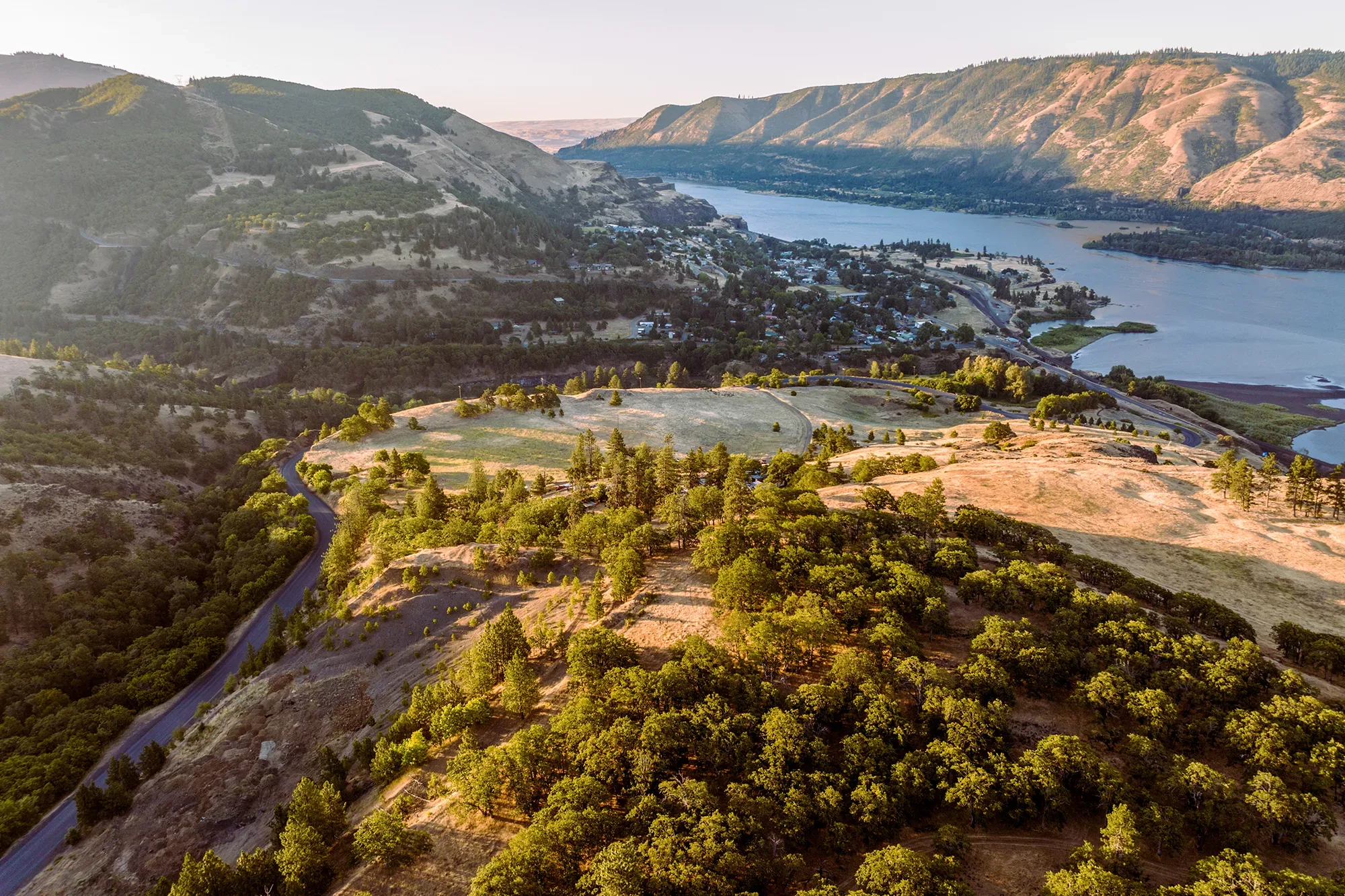Peregrine Falcon (Falco peregrinus)
The Peregrine falcon can be found nearly everywhere in the world from the tundra to the rainforest, to right here at Lyle Cherry Orchard! The fastest animal species in the world, reaching speeds upwards of 200 mph as they dive to catch their prey, Peregrines thrive in cliff-ledge environments near bodies of water, which is why they do so well in the Gorge. They primarily eat other birds including pigeons, large gulls, and songbirds. Sometimes they can be observed eating small mammals, but birds make up the majority of their diet. They are thought to be monogamous, meaning they mate for life. Breeding season occurs every March to May where 2-4 eggs are laid and incubated by both the female and male. It takes approximately 30 days for the eggs to hatch. After about 42 days post-hatching, the chicks learn to fly and will stick with their parents to learn to hunt before being ready to go off on their own. Historically, Peregrine falcons in the United States were at risk of local extinction due to a pesticide called DDT (Dichloro-diphenyl-trichloroethane). This pesticide caused eggshell thinning and breaking of eggs and was outlawed in the 1970s. Thankfully, after the ban of the pesticide, the falcon’s populations have recovered. They are protected under the Migratory Bird Act. Threats to Peregrine falcons today include habitat loss, wind turbine collisions, and pesticide poisoning.
The Peregrine falcon’s superpower is SPEED! They are expert hunters, flying high up in the sky as they watch for unlucky birds flying below. Once their target is locked, they nosedive hitting speeds of over 200 mph until they catch their prey! Fun fact: the highest recorded speed of a Peregrine falcon was 242 mph.
Western Gray Squirrel (Sciurus griseus)
The Western gray squirrel (now considered endangered in Washington State) can be found in various locations along the West Coast, but in Washington State there are only three isolated populations left, one of which is here in Klickitat County. They are the largest species of tree squirrel found in the Pacific Northwest and thrive in environments where they have access to oak woodlands and conifer forests. These squirrels need large mature trees for both nesting opportunities and a diverse selection of vegetation to provide a variety of food sources. The Western gray squirrel primarily eats seeds, nuts, and berries. However, they are opportunistic feeders meaning when they are hungry, they will eat what is around them, consuming things like insects, bird eggs, and fungi. These squirrels mate in early winter through late spring with litters of 2-4 seen anywhere from March to June. Once baby squirrels are approximately 3 months old, they are on their own to forage, staying close to their parents until the next mating season. Often confused with the introduced Eastern gray squirrel that can be seen primarily in urban areas around the Gorge, the Western gray squirrel can be identified by its large size, bushy tail, and lack of any brown coloration on its body or tail. The biggest threats to the Western gray squirrel are habitat loss, forest fires, logging, and invasive weeds. Lyle Cherry Orchard’s sprawling oak woodlands are the ideal habitat for this squirrel.
The Western gray squirrel’s superpower is HIDING! They are experts at storing their food for later by using abandoned animal burrows, hollow trees, flowerpots, and even abandoned cars! By storing their food, they can easily go back and retrieve it when food isn’t readily available.
Western Fence Lizard (Sceloporus occidentalis)
The Western fence lizard can be found throughout the Western United States and parts of Mexico and Canada, but in the Gorge, you can find them east of the Cascade Mountain Range, including here at Lyle Cherry Orchard. These lizards are medium-sized with average lengths of 2.2-3.4 inches snout to vent. They are brown and gray in color with mature adults having blue patches on the side of the abdomen and throat. This blue coloration is bright in males and faint in females. They thrive in many habitats including sagebrush, grasslands, oak woodlands, and ponderosa forests. However, they avoid wet forests. These lizards are insectivores with a diet consisting of small insects and arachnids. They breed in early spring to summer and can lay anywhere from 3-17 eggs. These eggs will hatch approximately 2 months later and leave their parent immediately. What makes these lizards unique is a protein in their blood that is known to kill the bacteria that cause Lyme disease. When infected ticks feed off the lizard’s blood, the protein kills the disease which prevents further spread. The biggest threat to the Western fence lizard is habitat loss.
The Western Fence Lizard’s superpower is CAMOUFLAGE! They are well-adapted to live at Lyle Cherry Orchard and other habitats in the Gorge, as their gray and brown coloration allows them to blend into their surroundings to prevent them from becoming prey.
Western Rattlesnake (Crotalus oreganus)
The Western rattlesnake can be found east of the Cascades Mountain Range in Washington and Oregon. They primarily can be found in shrubsteppe habitats (low-rainfall grasslands) but also live in open oak woodlands and ponderosa forests. The snakes can be found here at Lyle Cherry Orchard! In the winter, they primarily are found in talus and basalt outcroppings when they are less active. The Western rattlesnake’s diet primarily is small rodents, but they also consume lizards, ground-dwelling birds, and other snakes. With average lengths of 2 feet in this region, this is a relatively small snake. It can be identified by its wide triangular head and a rattle at the tip of its tail–lookalikes in the area include the non-venomous gophersnake which has a much smaller head, lacks a rattle, and tends to be larger in size. Rattlesnakes are viviparous, meaning they give live birth, unlike other snakes who lay eggs and incubate them prior to hatching. These snakes are most active during the day except for extreme high temperatures in summer where they are nocturnal. Breeding season is in spring and young snakes start appearing in August. These snakes are venomous and can be dangerous. However, they rarely bite unless picked up, harassed, or accidentally stepped on, so use caution when hiking in rattlesnake habitat. These snakes’ biggest threats are unnecessary killing, habitat loss, and destruction of communal den sites.
The Western Rattlesnakes superpower is VENOM! Rattlesnakes inject venom into their prey to immobilize them. This ability allows them to be effective hunters and keeps their prey from escaping. Fun fact: The venom helps them digest their food more effectively!
Lewis’ Woodpecker (Melanerpes lewis)
The Lewis’ woodpecker can be found primarily in the Western and Central United States, but has winter ranges as far south as Mexico and summer ranges as far north as Canada. They thrive in a variety of habitats including open ponderosa forests, burned forests with snags (dead trees), and oak woodland environments like we see here at Lyle Cherry Orchard. The Lewis’ woodpecker consumes mostly flying insects during the spring and summer, and in the fall and winter they eat nuts, seeds, and fruits, and will store broken-off pieces in bark crevices and holes in trees. These birds are protective of their winter food storage, and when an intruder is near, they will chatter, lift their beak, and puff their feathers to warn them off. They are particularly aggressive towards other species of woodpeckers. They will also use other species of woodpeckers’ abandoned crevices or well-decayed snags for nesting as their beak isn’t as equipped to dig into live trees like other woodpeckers. These birds will lay between 5-9 eggs each year that take approximately 2 weeks to hatch. The baby birds will stay in the nest for about a month after hatching. The biggest threats toward the Lewis’ woodpecker include fire suppression, habitat loss, and climate change.
The Lewis woodpecker’s superpower is CATCHING! Unlike other woodpeckers, the Lewis’ performs acrobatic flights to catch its prey mid-air. From its perch on a branch, this woodpecker watches the sky for flies and other insects. Once it spots one, the show is on!
Latest News

Celebrating the 20th Anniversary of Friends’ Land Trust

2025 Legislative Sessions: Wins and Challenges in Oregon and Washington


